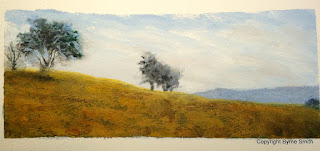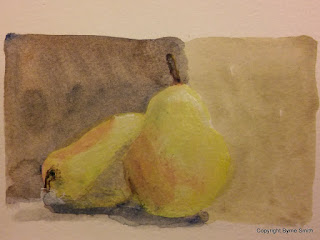 |
Overlook Ridge
Acrylic on Arches 140-lb. Paper
12 x 7 in/30.5 x 17.8 cm
Copyright Byrne Smith 2016 |
Over the years I have read about, Googled, and studied up on the color palettes of some painters whose work I admire--both living and dead.
I wanted to know what colors these talented painters used so that I could paint just like them (in my dreams). Of course, that's not how it works, but learning what colors they use(d) helped me to discover my own palette. Here are some of my thoughts.
Monet only used the colors and types of paint available during his lifetime. However, even comparing them with modern equivalents it's plain to see his palette was, more or less, made up of a combination of cool and warm primaries. He did add those greens, though--viridian and emerald--which almost no contemporary painters do. Oh yeah, and black.
John Hammond, a contemporary acrylic painter, uses the following blues on his palette: cerulean, pthalo, and light blue violet. Interesting choices.
Not counting white, Kevin MacPhereon appears to have the most limited palette of today's painters: ultramarine, cad red light, cad yellow pale, alizarin crimson, and pthalo green.
Mark Boedges, a very popular
plein air painter, has a lot of colors on his palette including three reds, three blues, two yellows, two greens, and two oranges, not to mention yellow ochre pale and terra rosa (don't know if he uses all these colors all the time).
Colley Whisson, the Australian impressionist, uses a combination of warm and cool primaries (like Monet did) plus cad orange and yellow ochre, which suits his high-key, sun-filled landscapes.
My current palette was loosely based on Colley Whisson's (and I suppose Monet's, too). However, on his palette and others there are some colors that just don't work for me.
I don't do well with cerulean blue for some reason. When I use it, my paintings take on an unpleasant greenish cast. I've tried many times, always with the same result. I have surprisingly better results using pthalo blue.
Ditto for cad orange. Somehow when I use it. it neutralizes other colors and goes a warm gray. Fine if that's what I intended, but it never was.
My current palette (drum roll please): alizarin crimson hue, cad red light, burnt sienna, lemon yellow, cad yellow light, yellow ochre, ultramarine, pthalo blue, burnt umber (sometimes), light blue violet (sometimes) and titanium white, of course.
My palette is subject to change, though, and I currently want to try out pthalo green. We'll see. I hope you have made your color palette your own, too.






















